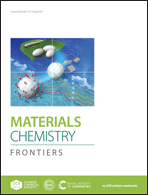New organic–inorganic hybrid materials: high refractive index polymers based on cyclotriphophazene with high thermostability and transparency†
Abstract
Two flexible and colorless high refractive index films based on cyclotriphophazene have been successfully prepared by the thiol–ene reaction of hexa-substituted cyclotriphophazene monomer (CVP) and commercial bifunctional aromatic thiol. The new organic–inorganic hybrid polymers exhibit high transmittance of 89% varying from 550 nm to 2000 nm and transmittance is still more than 87% even at 2500 nm, as well as good thermostability with a 5% weight loss temperature (T5d) of over 320 °C and a glass transition temperature (Tg) of up to 163 °C. Moreover, the polymers show high refractive indices (n) of 1.673 and 1.706 at 550 nm. In particular, the polymers also display stable optical properties with a transmittance of 88% and n of 1.673, 1.701 at 550 nm, even after immersing them in water at room temperature for 2 days. In addition, the polymers exhibit good mechanical properties and dimensional stability. These data indicate that the new inorganic–organic hybrid polymers are desirable as optical encapsulation resins for light-emitting diode (LED) devices and antireflective coatings.



 Please wait while we load your content...
Please wait while we load your content...